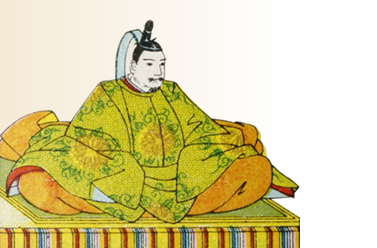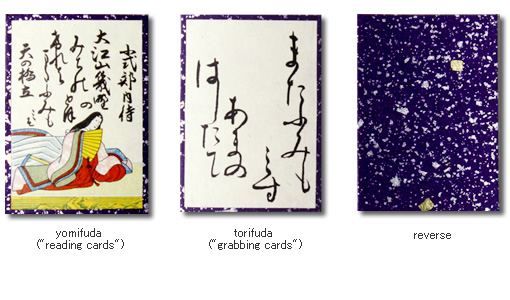 |
 |
 |
| A Hyakunin Isshu is a collection of one hundred poems, one each by one hundred poets. There are numerous such collections, including the "Warrior Family Hyakunin Isshu," the "Gosen Hyakunin Isshu," the "Genji Hyakunin Isshu" and the "Women's Hyakunin Isshu." Among these the most famous is the "Ogura Hyakunin Isshu," and under its influence the others were made. | ||
In the Kamakura era, a poet named Fujiwara Sadaie selected one great poem each from the works of one hundred poets, and arranged these works--representing some six hundred years of history--in order of creation. The works he chose were all themselves taken from ten poetry anthologies, such as the Kokin and the New Kokin, which had been prepared for various emperors. Fujiwara's anthology was called the Ogura Hyakunin Isshu, after the area of Japan in which he lived. In the one hundred Ogura poems, the most prevalent theme is that of love with 43 poems devoted to it. The season of fall is the second most common theme, with 16 of the poems. Within the one hundred poets there are 21 females represented, 79 males and 15 monks. |
||
Today, the Hyakunin Isshu is particularly well known in Japan for its adoption for use in the card game "karuta." Karuta is said to have its roots in the shell-matching games played in the Heian era (794 to 1185). In these, the separate sides of a number of shells were separated, with the players then having to find pairs. It then became practice to write poems or paint pictures on these shells. Hyakunin Isshu first appeared on playing cards in the Sengoku Warring States period (from the 15th to the 17th centuries). These cards were at first used in the imperial court and by the wives and harem girls of the daimyos. In time these card games came to be a regular seasonal event. Karuta was not originally the province of the common people, but the spread of wood block printing in the Edo era (1603 to 1868) led to the popularization of playing cards as a tool for teaching counting. This in turn led to the game's popularization among ordinary people during the Genroku era (1688 to 1704). It is believed that it finally became a fixture of Japanese New Year family celebrations during the Ansei era (1854 to 1860). |
||
A full set of cards consists of two hundred: one hundred yomifuda ("reading cards") and their corresponding hundred torifuda ("grabbing cards"). Both faces are made of layered paper, and it is not possible to distinguish the yomifuda and torifuda by their construction, materials or reverse sides. Each yomifuda features the name of one of the one hundred poets, their portrait and their famous poem. The torifuda features just the last part of the poem, written in simple hiragana script. The yomifuda are brightly and individually decorated, but with only script on the torifuda they are more difficult to tell them apart. |
||
 |
||
|
|
||||||||
|
|
||||||||

|
|
||||
|
 |
 |
Today, the finest Hyakunin Isshu cards available are these Kahou cards, produced using a combination of expert techniques. A unique process of layering paper creates cards which are pleasant to touch and are not too thick, yet are surprisingly and impressively sturdy. The yomifuda reading cards are printed 13 times and the torifuda grabbing cards 4 times with special colors, producing beautiful designs that have the splendor of a picture scroll. The box too is of the highest quality, made of ginko wood, lacquered and decorated with pure gold maki-e. With attention lavished on all aspects of its production, from the materials to the hand-made construction and finished appearance, this is a Hyakunin Isshu set to surpass all others. |
|
 |
 |
 |
The fronts of the cards feature Echizen Torinoko paper, and the printing is checked after each color is laid down. The core of each card is a layered assembly of paper. The backs of the cards are not printed but rather sprinkled with gold and silver foil, giving them a beautiful appearance and making them a pleasure to touch. Presented in a wooden box covered in Echizen lacquer and finished with a tasseled scarlet cord, you are struck by the air of quality before you even see the cards. Created by hand with absolutely no compromises made, it is safe to say that this set is in the top rank of Hyakunin Isshu karuta cards. |
Recalls and creates a direct connection with the kinder, more relaxed 4th- to 8th-century period, during which the poetry in the Manyou anthology was written. In the 50th year of the Showa era (1975), 100 famous poems were chosen from the 4,516 in the Manyou anthology, and at New Year's ten years later this Manyou Karuta was unveiled. In contrast to the grand, lofty and elegant world of the Ogura Hyakunin Isshu, the Manyou features many poems that describe simple everyday life. Warmth and spirit has gone into the creation of this set, which lets you experience a part of the Manyou era of long ago. It can truly be called a work of art. |
Pains have been taken here not only with the cards but also with the wood box, made of highest-quality paulownia. The front of each card features Echizen Torinoko paper, and the printing is carefully checked after each color is laid down. The backs of the cards are not printed, but rather carefully sprinkled with gold and silver foil, giving them a beautiful appearance and making them a pleasure to touch. The box itself is unspoilt by any unnecessary decoration; enjoy the warmth and beauty of the natural material. |
 |
 |
 |


























